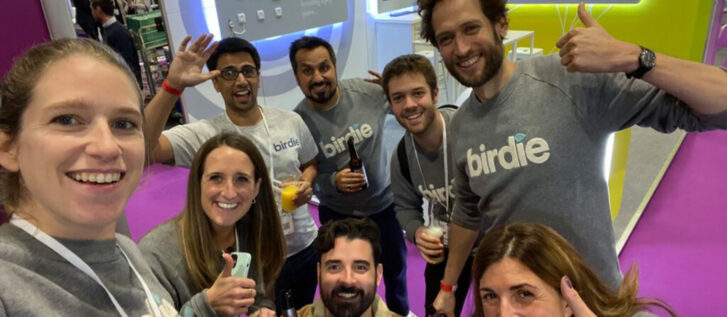
The importance of male allyship
It’s rewarding to win awards and recognition for promoting greater diversity, but they...read more
Top firms came together to discuss how they’d coped with the pandemic so far and share best practice on agile working for working parents

Communication, support and flexibility emerged as key themes at a recent virtual round table on agile working best practice.
Nine organisations were brought together by workingdads.co.uk’s sister site workingmums.co.uk to share their experiences and lessons learned.
Discussing what’s worked and what hasn’t over recent months is key to making the most opportunities going forward and embedding change that benefits working dads and working mums as well as their employers.
The round table event on agile working best practice was hosted by Gillian Nissim, founder of workingmums.co.uk and workingdads.co.uk. She spoke about the organisation’s commitment to sharing and promoting best practice in diversity and flexible working. And she highlighted the need for employers to come together to talk about the challenges they face with regard to the pandemic.
Employers spoke about how many had been quickly thrown into remote working. Some admitted to not being particularly agile before the pandemic but they were keen to be more proactive going forward. Others had been doing flexible working for some time, but wanted to learn more about how they can improve agile working, which they felt needed to be clearly defined. Some employers were having to recruit rapidly in response to the coronavirus and because of social distancing and a reduction in office space over recent years many had to work from home. Others worked with career returners who need support. Some feared shift patterns had become more rigid during the pandemic, making them less agile.
Employers spoke about how, post-lockdown, they were rethinking how they worked. Trialling more smart working with technology was a common experience. Some are also focusing on building individual relationships.
Contact centres and how to support remote contact centre workers was one issue that came up. One employer spoke of how they had handled the response to the pandemic in their contact centres. They initially worked in hubs to mitigate the spread of illness but quickly realised that they would have to move to homeworking. This was done within a couple of weeks. There were some teething issues around IT, but it had been generally successful. Having a roadmap and a strong business need helped focus minds.
Contact between teams was maintained through WhatsApp and chat functions. Managers did regular check-ins so people were not isolated. They were now managing a phased return to work for those in other parts of the business who couldn’t work from home, based on critical business need and people’s confidence about returning to work, based on surveys. They were prioritising those who needed to return, for instance, those who felt very isolated, had IT issues or were living in shared accommodation and finding homeworking difficult.
Another employer which had run a homeworking contact centre pilot before the pandemic spoke of their positive experience and what they had learnt. They had tried to foster a team spirit from the start and moved everything online from recruitment to training, using a remote trainer, Adobe connect and Zoom. Contact centre workers had chat running the whole time; senior supervisors used Skype for Business to get an overview of the issues that were arising. They put in an escalation support desk so that managers were not overrun with questions and so that employees had a point of contact if they needed immediate help. As part of the response to the pandemic, they scaled back head count and changed their operating hours. That meant there was actually less flexibility in shifts that were available.
Other customer-facing employers had tried to maintain regular working hours so there was not too much change for customers. Staff who could not work regular hours [for instance, due to childcare issues] were redeployed to tasks like data inputting and administration. They focused on understanding what people could and couldn’t do and whether flexing hours would help.
Some employers, such as those in the retail sector, have not been able to work from home. However their head office teams have been able to do so. One employer spoke of how working from home had gone from being frowned upon to being accepted as an effective way to work. The change to working from home had been quick and sessions had been run for line managers on motivating and managing remote teams.
The managing director had hosted a session for furloughed workers every week. Crucially, the message was clear from senior managers that having children present was okay, that people do not have to pretend that they are working as normal and that they can only do their best in the circumstances they face. The flexibility and trust shown had been rewarded with increased productivity. The business had had “a light bulb moment” and it was now important to figure out how to embed that.
Other employers echoed this, saying they had seen no drop in productivity due to homeworking. Clients were in a similar situation so there was more understanding generally about flexible working.
Many employers surveyed staff to check how they were doing. Asking employees for their views brought interesting responses. On the whole, older workers wanted greater agility. Younger employees favoured working in an office environment. Others favoured a hybrid approach and felt coming into the office a few days a week would help their mental well being and provide a change of environment. That meant employers had to be flexible to different employees’ needs at different times and embed agile policies in an overall culture and organisational strategy. They also needed to be clear what agile working meant and that it was not just about working from home.
As lockdown eased it was important to maintain good communications. This meant asking how people felt about coming back; how they would come back; providing a realistic view of what working in the office would be like and how different it would be from what it was before the pandemic.
Employers said they had seen a surge in joiners to parent and carer networks. Parents were keen to share the diversity of their experiences depending on their circumstances, the ages of their children, whether they were single parents and other criteria. Many were exhausted.
There was general concern about possible burnout from parents working double shifts. One employer recognised early on that the pandemic was an endurance test for parents, They clocked that offering flexi hours in the evenings and weekends could lead to exhaustion and felt it was better to simply accept lower productivity given the circumstances. This helped to relieve stress among parents.
That meant leading from the top. Management worked with the firm’s parents network and partnered with a mental health organisation to target useful information to parents and carers at different times of the day. Over 200 employees participated in 18 sessions. At the start people were not very forthcoming, but by the end parents and carers were sharing experiences about what they were facing.
Employers generally said parent networks or channels for parents were vital. Some said their networks had grown significantly as a result of interaction during lockdown.
Several employers spoke of the first weeks of lockdown being very difficult for line managers. One called it a “baptism of fire” as they switched to remote working. HR support was crucial. Managers had to learn as they went along and it was a huge joint learning experience. Employers supported this with guides on remote working as well as surveys that highlighted where employees were struggling. Some line managers were really under pressure and, while they could manage in the short term, they needed ongoing support.
Support was given to encourage them to listen to employees with empathy and care and to focus on relationship building. One employer spoke of the need to focus on team accountability so all the strain did not fall on managers. Team members needed to be encouraged to care for each other and to be aware when colleagues were having ups and downs, which applied to everyone. How employers cared for their people was more important now than ever, which included preparing for the longer term impact of the pandemic and ensuring staff took time off and that managers kept in regular contact in a fast-moving situation.
Department for Work and Pensions
Pitney Bowes
PepsiCo
Enterprise Rent-A-Car
Volkswagen
Enterprise Holdings
Morgan Sindall Infrastructure
WH Smith
Schneider Electric
FDM Group

Mandy Garner talks to birdie, winner of this year’s Best for SMEs category in the WM People Top Employer Awards. read more

The second instalment of our podcast has been released in which we talk about the Top Employer Awards 2023, mental health and ITV's Maternal. read more

We've had to adapt quickly to a new way of flexible working, especially with poor mental health affecting so many people working from home. So what... read more

The on site nursery is a huge benefit to parents at Next's HQ. But the family friendly culture runs right through the firm read more